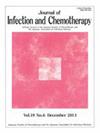Evaluation of the efficacy of step-down therapy with oral minocycline for complicated pyelonephritis caused by extended-spectrum β-lactamase-producing enterobacterales: A retrospective cohort study
IF 1.9
4区 医学
Q3 INFECTIOUS DISEASES
引用次数: 0
Abstract
Background
Extended-spectrum β-lactamase-producing Enterobacterales (ESBL-E) infections present significant treatment challenges owing to limited oral antibiotic options. Minocycline is active against ESBL-E; however, its efficacy remains unclear. This study evaluated the efficacy of step-down therapy using oral minocycline for complicated pyelonephritis (cPN) caused by ESBL-producing Escherichia coli.
Methods
This retrospective cohort study, conducted at Tohoku Rosai Hospital (2018–2023), included hospitalized patients with cPN and ESBL-E infection. Seventy-two patients receiving intravenous antibiotics followed by oral therapy were classified into the conventional or minocycline therapy groups. Primary outcomes were recurrence within 30 and 90 days post-treatment, whereas secondary outcomes included resolution of fever within 48 h, hospital stay, and adverse events. Propensity score matching (PSM) and inverse probability of treatment weighting (IPTW) were performed.
Results
No significant differences were observed in recurrence or fever resolution; however, hospital stay was shorter in the minocycline group than in the conventional group (PSM: p = 0.027; IPTW: p = 0.033, respectively). No adverse effects were noted, although one Clostridioides difficile infection case occurred in the conventional group. ESBL-producing E. coli was detected more frequently in the minocycline therapy group (p = 0.005), and patients with minocycline minimum inhibitory concentration (MIC) ≥4 μg/mL had higher relapse rates (p = 0.006) than those in the conventional group.
Conclusions
Among ESBL-E, particularly in E. coli, step-down therapy using oral minocycline for cPN appears as effective as conventional therapy and may shorten hospital stays. However, as minocycline MICs ≥4 μg/mL may be associated with recurrence, clinicians should verify MIC values before prescribing minocycline.
口服二甲胺四环素降量治疗广谱β-内酰胺酶产肠杆菌引起的复杂肾盂肾炎的疗效评价:一项回顾性队列研究
由于口服抗生素选择有限,产β-内酰胺酶肠杆菌(ESBL-E)感染的治疗面临重大挑战。米诺环素对ESBL-E有活性;然而,其功效尚不清楚。本研究评估口服二甲胺四环素降压治疗由产esbl大肠杆菌引起的复杂肾盂肾炎(cPN)的疗效。方法本回顾性队列研究于2018-2023年在东北罗赛医院进行,纳入住院的cPN和ESBL-E感染患者。72例患者接受静脉注射抗生素后口服治疗,分为常规治疗组和米诺环素治疗组。主要结局是治疗后30天和90天内的复发,而次要结局包括48小时内发热消退、住院时间和不良事件。进行倾向评分匹配(PSM)和逆概率处理加权(IPTW)。结果两组患者的复发率和发热消退率无显著性差异;但米诺环素组住院时间短于常规组(PSM: p = 0.027;IPTW: p = 0.033)。虽然在常规组中发生了一例艰难梭菌感染病例,但没有发现不良反应。米诺环素治疗组产esbl大肠杆菌检出率较高(p = 0.005),米诺环素最低抑制浓度(MIC)≥4 μg/mL患者复发率高于常规治疗组(p = 0.006)。结论在ESBL-E中,特别是大肠杆菌中,口服二甲胺四环素治疗cPN的降压治疗与常规治疗一样有效,并可能缩短住院时间。然而,由于米诺环素MIC≥4 μg/mL可能与复发相关,临床医生在开米诺环素处方前应验证MIC值。
本文章由计算机程序翻译,如有差异,请以英文原文为准。
求助全文
约1分钟内获得全文
求助全文
来源期刊

Journal of Infection and Chemotherapy
INFECTIOUS DISEASES-PHARMACOLOGY & PHARMACY
CiteScore
4.10
自引率
4.50%
发文量
303
审稿时长
47 days
期刊介绍:
The Journal of Infection and Chemotherapy (JIC) — official journal of the Japanese Society of Chemotherapy and The Japanese Association for Infectious Diseases — welcomes original papers, laboratory or clinical, as well as case reports, notes, committee reports, surveillance and guidelines from all parts of the world on all aspects of chemotherapy, covering the pathogenesis, diagnosis, treatment, and control of infection, including treatment with anticancer drugs. Experimental studies on animal models and pharmacokinetics, and reports on epidemiology and clinical trials are particularly welcome.
 求助内容:
求助内容: 应助结果提醒方式:
应助结果提醒方式:


